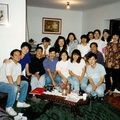My first night in São Paulo, Brazil was like Mr. Toad’s Wild Ride at Disneyland.
Based on my first experience of riding in a car in São Paulo, these would be my understanding of the driving rules:
- There are lines on the street. They are painted there for no reason whatsoever. Two lanes on the roadway can have four lanes or more of traffic. Oh, and the shoulder adds another two lanes.
- Traffic signals are not rules. They are guidelines. After 10pm, they are virtually meaningless.
- You have a horn. Use it at every opportunity. Four to five times in one block. If another car pulls out in front of you, don’t slow down. Honk.
- Every driver considers him/herself the embodiment of Formula One driver Ayrton Senna. Senna was idolized by the nation before and after his death on the F-1 circuit.
- Cars, not pedestrians, have the right-of-way. Car is king. (As a pedestrian, I was nearly hit on several different occasions throughout the years having forgotten this rule).
- Don’t use your headlights at night.
This is actually the weirdest. My homestay host and his son took me out for a Friday night tour of the city on my first weekend. As we pulled out of his driveway, I looked at the road ahead and said, “I don’t think your lights are on.”
He said, “They’re not.”
Why not? Because back in the day (1990), it was considered rude to shine your headlights into oncoming traffic on the city streets. So they drove at night with something equivalent to parking lights, flashing their headlights only when driving through intersections against the signal (see Rule 2).
It was, needless to say, a harrowing experience.
As we drove through various bairros of the city, we slowed down and stopped at a traffic light. Please refer again to Rule 2. The son, sitting in the back seat leaned forward and asked his father, “Dad, why did we stop at the stop light?”
My host’s answer? “Well son, we don’t want to scandalize too often or too much our young American friend.” I couldn’t help but laugh.
Another option in São Paulo which one might consider safer is riding the city bus. Let me see if I can find the adjectives to describe this experience. Twisting and turning. Bouncing up and down! Sliding across the width of your bench seat! Sounds like the newest thrill ride at Six Flags, doesn’t it?
My favorite was the bus that took me from the metrô station at Santa Cruz to the stop in front of my apartment on Avenida Itaboraí in Bosque da Saúde. The neighborhood was made up of hills and very eccentric streets which had both snaking turns and deep dips. Sharp curves and bone-jarring bumps.
There were no CalTrans standardizations on these streets!! The right and left curves were awesome, sometimes coming right on top of each other! You could be hanging on for dear life to the pole in the aisle, and suddenly be slung around in the opposite direction as the bus swerved to:
- make a turn,
- avoid a collision,
- stop for a light (ha ha!), or
- make the passengers fall out of their seats!
To the curves, add the vertical movement that come as the bus hit a dip or a speed bump at 35 mph! (Hey! This is a culture of machismo. The driver doesn’t slow down!)
The best place to experience this kind of bus ride was in the very back bench seat against the back window. On one occasion, when my bus hit those dips in the road, the frame of the bus had a vertical displacement of about three feet, resulting in my head bouncing off of the bus’ ceiling!! From a sitting position!!
Whiplash, neck compression, skull bruising, arms wrenched out of sockets. All of these can be yours on the thrill ride called the São Paulo city bus!
By bus or by car, São Paulo is an exciting city!
© 2009 John Katagi







